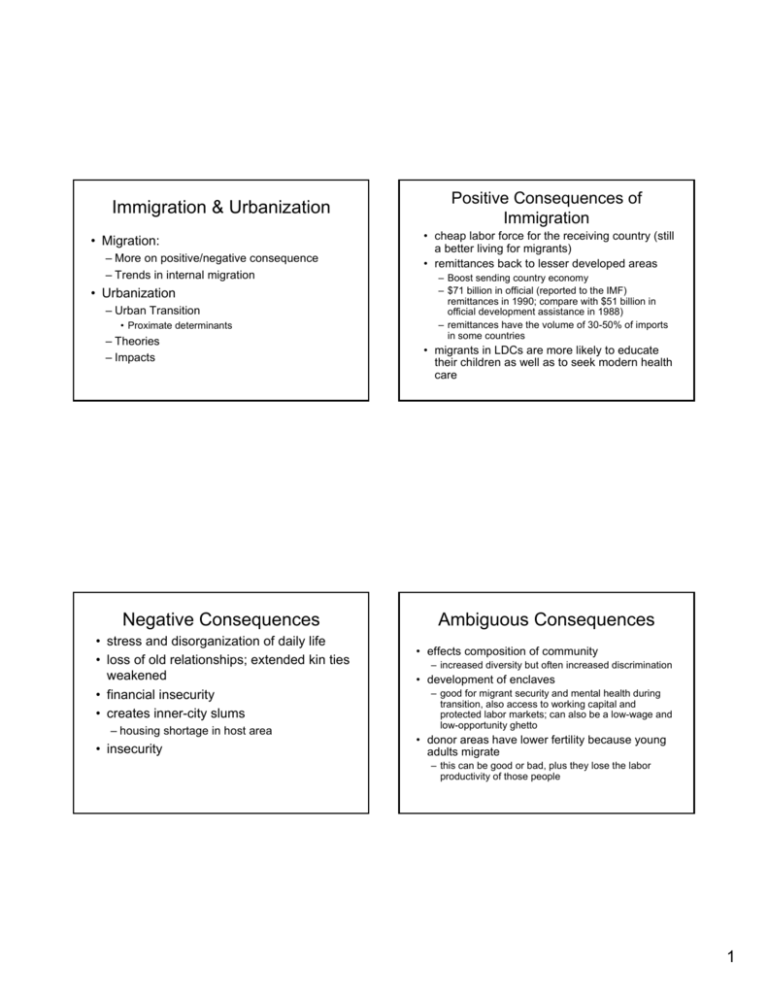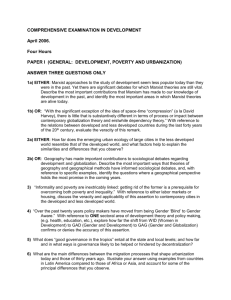Immigration & Urbanization Negative Consequences Ambiguous
advertisement

Immigration & Urbanization • Migration: – More on positive/negative consequence – Trends in internal migration • Urbanization – Urban Transition • Proximate determinants – Theories – Impacts Negative Consequences • stress and disorganization of daily life • loss of old relationships; extended kin ties weakened • financial insecurity • creates inner-city slums – housing shortage in host area • insecurity Positive Consequences of Immigration • cheap labor force for the receiving country (still a better living for migrants) • remittances back to lesser developed areas – Boost sending country economy – $71 billion in official (reported to the IMF) remittances in 1990; compare with $51 billion in official development assistance in 1988) – remittances have the volume of 30-50% of imports in some countries • migrants in LDCs are more likely to educate their children as well as to seek modern health care Ambiguous Consequences • effects composition of community – increased diversity but often increased discrimination • development of enclaves – good for migrant security and mental health during transition, also access to working capital and protected labor markets; can also be a low-wage and low-opportunity ghetto • donor areas have lower fertility because young adults migrate – this can be good or bad, plus they lose the labor productivity of those people 1 More Ambiguous Consequences • filling jobs natives don’t want • there is some controversy regarding whether remittances improve sending country economies or instead just fuel inflation • brain drain vs. brain overflow Internal Migration • In MDCs – To suburbs • In U.S. – South westward • Gravity Model of Migration: – does migration deprive developing economies of their brightest citizens? – does migration reduce educated unemployment Urbanization • Urbanization - redistribution from the countryside to the city • Therefore, urbanization is measured as the percent of the population residing in an urban area • Urbanization≠urban growth But how do we define “urban”? 2 Proximate Determinants of Urbanization: Urban is defined by: 1) population size 2) space 3) ratio of population to space - density 4) economic and social organization censuses and surveys usually employ some threshold population size (but with the ambiguity that the size of the space is not defined) Theories of Urbanization • Modernization theory – ties urbanization to demographic transition. • World-Systems theory – ties urbanization to position in world system. • • • • internal rural to urban migration international urban migration reclassification natural increase (indirectly) If: NI (rural) > NI (urban) then, rural areas release population pressure via migration to urban areas Impacts of Urbanization in MDCs Positive • higher wages • economies of scale • More social mobility Negative • crowding (applies to suburbs as well as central cities now) • More violent crime • pollution (suburbanization doesn’t help) • concentration of the poor in central cities (also the non-white; gentrification hasn’t changed this) 3 Additional Impacts of Urbanization in LDCs Positive • Lower fertility • Lower mortality • More opportunities for political participation Negative • More sexually transmitted disease • Expansion of amenities (water, education, sanitation) failing to keep pace with urban growth • Relative disenfranchisement of rural residents Why doesn’t urbanization stop when urban advantages diminish due to overcrowding and insufficient expansion of services? 4






